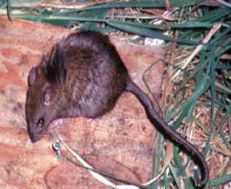| Taxon ID: 48,247 Total records: 39,143 | ||||||||||||||
Rattus exulans
Country
| Country | Myanmar |
|---|---|
| Continent Ocean | Asia |
Classification
| Kingdom | Animalia (COL) |
|---|---|
| Phylum | Chordata (COL) |
| Class | Mammalia (COL) |
| Order | Rodentia (COL) |
| Family | Muridae (COL) |
Taxonomy
| Genus | Rattus | Reference | |
|---|---|---|---|
| SubGenus | Vernacular Name | ||
| Species | exulans | IUCN Threat Status-Year | Least Concern, 2008 |
| SubSpecies | Nat'l Threat Status-Year | Not Evaluated, 2000 | |
| Infraspecies | Reason for Change | ||
| Infraspecies Rank | CITES | ||
| Taxonomic Group | Mammals | Native Status | Native |
| Scientific Name Author | Peale, 1848 | Country Distribution | Myanmar |
| Citation | Description | Geographic Range [top]
Range Description: This species is widespread throughout both mainland and insular Southeast Asia (including the islands of Taiwan, Sumatra, Java, Bali and Borneo) (Corbet and Hill 1992; Musser and Carleton 2005). It is likely introduced and widespread in the Philippines and several Indonesian islands (including Sulawesi, Buru, Lombok, Sumbara, Flores), the island of New Guinea (approximate range only given). It has also been widely introduced throughout the Pacific (Corbet and Hill 1992; Musser and Carleton 2005). It is now extinct from North Island, New Zealand (Flannery 1995). The map for this species depicts only an estimate of the species extensive range.
Countries occurrence:
Native:
Bangladesh; Cambodia; Indonesia; Lao Peoples Democratic Republic; Malaysia; Myanmar; Thailand; Viet Nam
Introduced:
American Samoa (American Samoa); Brunei Darussalam; Christmas Island; Cocos (Keeling) Islands; Cook Islands; Fiji; French Polynesia; Guam; Kiribati; Marshall Islands; Micronesia, Federated States of ; Nauru; New Caledonia; New Zealand; Niue; Norfolk Island; Northern Mariana Islands; Palau; Papua New Guinea; Philippines; Samoa; Singapore; Solomon Islands; Timor-Leste; Tokelau; Tonga; Tuvalu; United States (Hawaiian Is.); United States Minor Outlying Islands; Vanuatu; Wallis and Futuna
Present - origin uncertain:
Taiwan, Province of China
Additional data:
? Upper elevation limit (metres): 250
Range Map: Click here to open the map viewer and explore range.
Population [top]
Population: It is an abundant species.
Current Population Trend: Stable
Additional data:
? Population severely fragmented: No
Habitat and Ecology [top]
Habitat and Ecology: This species is present in a wide variety of habitats, including disturbed or agricultural land. In the Philippines, it occurs in agricultural areas throughout the country at all elevations (Barbehenn et al. 1973; Rabor 1986). Often present in disturbed forest (e.g. Danielsen et al. 1994), usually rare in primary forest, but may be common in primary forest on islands such as Negros with few native rodents (Heaney et al. 1989). In South Asia, it is a nocturnal and probably commensal species. It occurs in tropical and subtropical dry deciduous forests, tropical and subtropical mangrove forests. Coastal hilly forest with human settlements in lowlands (Molur et al. 2005).
Systems: Terrestrial
Threats [top]
Major Threat(s): There are no major threats to this species.
Conservation Actions [top]
Conservation Actions: It is presumably present in many protected areas.
Citation: Ruedas, L., Heaney, L. & Molur, S. 2008. Rattus exulans. The IUCN Red List of Threatened Species 2008: e.T19330A8854350. http://dx.doi.org/10.2305/IUCN.UK.2008.RLTS.T19330A8854350.en. Downloaded on 02 December 2016.
Disclaimer: To make use of this information, please check the |
|
| Source |
Record Level
Growth Parameters
| Temperature | 0 | Observed Weight | 0 |
|---|---|---|---|
| Sex | Previous Catalog Number | ||
| Life Stage | Relationship Type | ||
| Preparation Type | Related Catalog Item | ||
| Individual Count | 0 | GML Features | |
| Observerd Individual Count | 0 | Notes |
Collecting Event
Images
|
Additional Info
Synonyms To Manage Synonyms for Rattus exulans, click this link: Synonyms. |
Epimys basilanus Hollister, 1913 ¦ Epimys calcis Hollister, 1911 ¦ Epimys leucophaetus Hollister, 1913 ¦ Epimys mayonicus Hollister, 1913 ¦ Epimys ornatulus Hollister, 1913 ¦ Epimys querceti Hollister, 1911 ¦ Epimys stragulum Robinson and Kloss, 1916 ¦ Epimys vigoratus Hollister, 1913 ¦ Mus aemuli Thomas, 1896 ¦ Mus bocourti Milne-Edwards, 1872 ¦ Mus buruensis J. A. Allen, 1911 ¦ Mus clabatus Lyon, 1906 ¦ Mus concolor Blyth, 1859 ¦ Mus ephippium Jentink, 1880 ¦ Mus ephippium negrinus Thomas, 1898 ¦ Mus luteiventris J. A. Allen, 1910 ¦ Mus obscurus Miller, 1900 ¦ Mus pantarensis Mearns, 1905 ¦ Mus pullus Miller, 1901 ¦ Mus surdus Miller, 1903 ¦ Mus todayensis Mearns, 1905 ¦ Mus vulcani apicus Mearns, 1905 ¦ Mus wichmanni Jentink, 1890 ¦ Rattus concolor equile Robinson and Kloss, 1927 ¦ Rattus concolor malengiensis Sody, 1941 ¦ Rattus concolor meringgit Sody, 1941 ¦ Rattus concolor otteni Kopstein, 1931 ¦ Rattus concolor solatus Kellogg, 1945 ¦ Rattus raveni Miller and Hollister, 1921 ¦ Rattus raveni eurous Miller and Hollister, 1921 ¦ Rattus schuitemakeri Sody, 1933 ¦ Togomys melanoderma Dieterlen, 1986 ¦ |
Common Names To Manage Common Names for Rattus exulans, click this link: Common Names. |
Little Rat () ¦ Pacific Rat () ¦ |
Localities To Manage Localities for Rattus exulans, click this link: Localities. |
Species Record Updated By:
Carlos Aurelio Callangan
|

